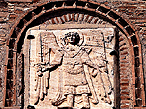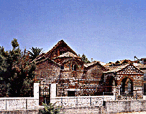 |
|
 |
The Despotate of Epiros
 n Arta, the capital city of the state of
n Arta, the capital city of the state of
 Epiros,
a large number of monuments survive that attest to the effort exerted by the ruling
Komnenodoukes family
to make the city an important centre and to enhance their own power and prestige. Artistic activity was at its most intense during the reign of
Michael II
(ca. 1230-60) and was mostly centred in the area of Arta itself. The dynamic despot and his wife, Theodora, who was canonised after her death, embarked on a Epiros,
a large number of monuments survive that attest to the effort exerted by the ruling
Komnenodoukes family
to make the city an important centre and to enhance their own power and prestige. Artistic activity was at its most intense during the reign of
Michael II
(ca. 1230-60) and was mostly centred in the area of Arta itself. The dynamic despot and his wife, Theodora, who was canonised after her death, embarked on a
 ambitious building programme, starting with the restoration of the older
basilica
of the monastery of Blacherna, which was adorned with an exceptionally fine painted and sculpted decoration and became the burial place for the rulers of the new state. In the wider area of Arta new churches were founded and older ambitious building programme, starting with the restoration of the older
basilica
of the monastery of Blacherna, which was adorned with an exceptionally fine painted and sculpted decoration and became the burial place for the rulers of the new state. In the wider area of Arta new churches were founded and older
 ones decorated, among them the Virgin of Brione, St Demetrios tou Katsoure, the monastery of Kato Panagia and that of St Theodora, the convent to which Theodora retired and where her tomb is situated. The church of the Virgin Pantanassa in Philippias and the monastery of the Transfiguration (Metamorphosis) in Galaxidi were also founded by the same ruling couple. This activity continued in the rule of Michael's son,
Nikephoros,
and his wife
Anna
Palaiologina. Thus, the state of Epiros was enriched with important works, in many of which, such as the mosaics of the church of the Virgin Paregoretissa, the influence of the art of the Capital is plainly visible. The fact that Nikephoros' wife Anna was a niece of
Michael VIII Palaiologos is believed to be a probable cause for the introduction of novel Constantinopolitan elements into the art of the Despotate. ones decorated, among them the Virgin of Brione, St Demetrios tou Katsoure, the monastery of Kato Panagia and that of St Theodora, the convent to which Theodora retired and where her tomb is situated. The church of the Virgin Pantanassa in Philippias and the monastery of the Transfiguration (Metamorphosis) in Galaxidi were also founded by the same ruling couple. This activity continued in the rule of Michael's son,
Nikephoros,
and his wife
Anna
Palaiologina. Thus, the state of Epiros was enriched with important works, in many of which, such as the mosaics of the church of the Virgin Paregoretissa, the influence of the art of the Capital is plainly visible. The fact that Nikephoros' wife Anna was a niece of
Michael VIII Palaiologos is believed to be a probable cause for the introduction of novel Constantinopolitan elements into the art of the Despotate.
|